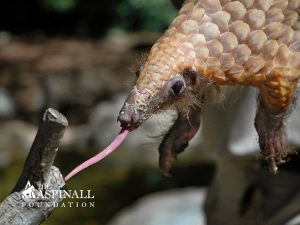Aspinall Update – March 2023
Pangolins
People might mistake a pangolin for a reptile with its pointed snout and scale-covered body. But in fact, pangolins are mammals and the only mammals in the world covered with scales. These scales protect them from predators and can also secrete a foul-smelling secretion from their anal glands, just like a skunk. The name” pangolin” comes from the Malay word “pengguling” which means something that rolls up, and they can be seen rolled into a tight ball when feeling threatened. Despite these wonderful defence tactics, they are the most heavily trafficked animal worldwide, traded for their meat, which is considered a delicacy, and their scales are used as traditional medicine in countries such as China and Vietnam.

Figure 1: A Pangolin rolls into a tight ball to protect itself.
There are eight species of pangolins, four of which are found in Asia and the other four across Africa. These shy creatures are nocturnal, feeding on ants and other insects with their long sticky tongues and sharp claws to break open termite mines. They can be found foraging on forest floors, often seeking shelter in tree hollows. Pangolins give birth to one baby per year, which can be seen attached to its mother’s back during the first three months of its life while its scales harden.
DCM Surfaces has been working with the Aspinall team in South Africa, providing funds to rescue illegally traded animals. In the past few months, they have rescued three pangolins, one of which had to be airlifted from a town called Mbombelo in South Africa. This poor animal was confiscated from illegal trade but, due to bus strikes, could not be transported by road. Using funding from DCM, the Aspinall team used a fixed-wing aircraft to transport the pangolin out of the city. This animal is now being rehabilitated and will soon be released back into the wild.

Fun Fact: A Pangolin’s tongue can grow up to 1/3 its body length!
The monthly contribution from DCM to the Aspinall Foundation in South Africa has provided much-needed funds for rescuing over 230 animals this year. Some of these rescues involve confiscating animals due to poor living conditions, such as saving a leopard by the SPCA and removing three lions being kept in someone’s backyard without a permit. Other rescues involve the removal of snares from different animals within reserves in South Africa.
There are also numerous incidents where wild animals breach the fences of the Game Reserves within which they are kept, and in order to prevent damage to the surrounding communities or to prevent them from being shot, these animals need to be driven back into their existing homes. These incidents often require helicopters to spot and chase animals back into the reserves, and the funding provided by DCM has allowed for the timeous response to two such incidents this year and the successful movement of both elephants and buffalos safely back to their homes.
Last Month’s Update:
If you would like to contribute towards the excellent work the Aspinall Foundation does, please see our latest project with the South African Aspinall Foundation, which includes the rehoming of a white rhino called Valentino via the Collection Pot.
All donations are welcomed, and continued updates of Valentino’s story will be posted as we get them.
Find out about the great work The Aspinall Foundation does via their website.